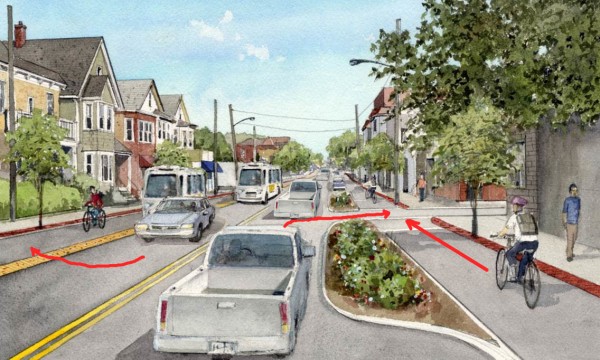I am writing in response to Alex Epstein’s letter, published as an article in the Somerville Patch, concerning the proposed cycle track treatment on Beacon Street.
I write as one of the cyclists who suggested an alternative design at community meetings and a public hearing, and as a cycling advocate of 35 years’ standing at the regional, state and national level.
You might think that the chair of the Somerville Bicycle Committee would seek support from all cyclists — after all, we are already a minority group among road users — but instead he indulges in this hateful, wildly inaccurate and grotesque stereotype:
…’vehicular cyclists,’ who sincerely believe that bicycles are cars and should not be ‘driven’ slower than 25 mph. They say if there’s a new separate place on the street for bikes that is 15 mph, more protected, and comfortable for the majority of the non-spandexed population, bicyclists will die. Pedestrians will be hit. The sky will fall.
Who, me? I rode my little folding bicycle to the meeting about Beacon Street on Tuesday evening, on Beacon Street, in street clothes. 25 miles per hour? Ha! I could dream. It was a bumpy ride, but it could get much worse.
The proposed eastbound cycle track would have a clear width of 4 feet between the door zone of parked cars and a 3-inch “reveal” curb — too narrow for one cyclist to overtake another safely. The proponents’ claim of a 15 mph (and substandard) design speed doesn’t reflect bicycle stopping distances, once the hood of a car blindly pokes its way across a driveway — the driver and the cyclist unable to see one another due to parked cars next to the driveway.
The proposed westbound cycle track would really be a bike lane with an added trip-and-fall hazard for cyclists – -a supposedly mountable curb on its street side. The gutter next to this curb would collect sand, debris, water and ice. The curb would make plowing the street a guessing game — “where is it under the snow? Oops — tore up some bricks.”
For a detailed discussion of design issues, please turn to the comment letter I wrote following the February 4 meeting.
Here is a drawing provided by the city, purporting to show how the street would look following the reconstruction. Note the unplowable brick mountable curb, but above all, note the radically low traffic volume. Where are all the people — bicyclists, motorists, pedestrians, people just hanging out? No people, no conflicts! Well, actually, there is one shown…that pickup truck.
Now let’s add some more typical road traffic and show some typical conflicts:
The traffic islands force all motorists to turn right from one lane to the left — and that’s how Chris Weigl died on Commonwealth Avenue. A proper design would have the bike lane to the left of a parking lane, and motorists merging across it to turn right.
The lack of parking on the far side of the street leads motorists to stop in the cycle track, as shown. The cyclist in the red shirt has just emerged out of a blind conflict and is at risk if the car next to him turns right into a driveway.
Will the project as proposed improve cycling conditions? Will it actually be “protected”? Will it make cycling safe for children? No. There is no specific detail about the design of the project in Mr. Epstein’s statement, because he has no facts to support it.
And as others have noted, the cycle tracks are only proposed for part of Beacon Street. The remainder would have door-zone bike lanes, just as it has now.
Let me also comment on the Boston Cyclists’ Union petition about this project. For a large percentage of the cycling population, “cycle track” is a buzz phrase. Sounds good! Gets me out of the way of those dangerous cars! Unfortunately, it takes time to describe whether a design will work in a particular location, and besides, the proponents avoid discussing the details.
The real goal of promotion of this project has nothing to do with convenience or safety of bicycle travel, and even less to do with equitably serving all of the populations which use Beacon Street. The bicycling advocates’ goal is to smash state and Federal bikeway design standards — to set a precedent so it becomes possible to get away with anything at all, just as is being proposed here. The Somerville mayor’s goal is evidently to advance his political ambitions. If he, other city officials or the design consultant understood the first thing about safe design for cyclists, they would steer clear of the proposed design. But at Tuesday’s meeting, they showed new drawings with new hazards.
Along with the other cyclists who opposed the project, I support David Olmsted’s proposal, discussed at the meetings, which would provide for bike lanes that are safely outside the door zone of parked cars over the entire length of the project, and would serve the majority of the cycling population, other road users, residents and businesses admirably well. No, not little children on bicycles, but you can’t have everything, and it is deeply unethical to claim safety while actually producing the opposite result.
Also see this earlier post.



